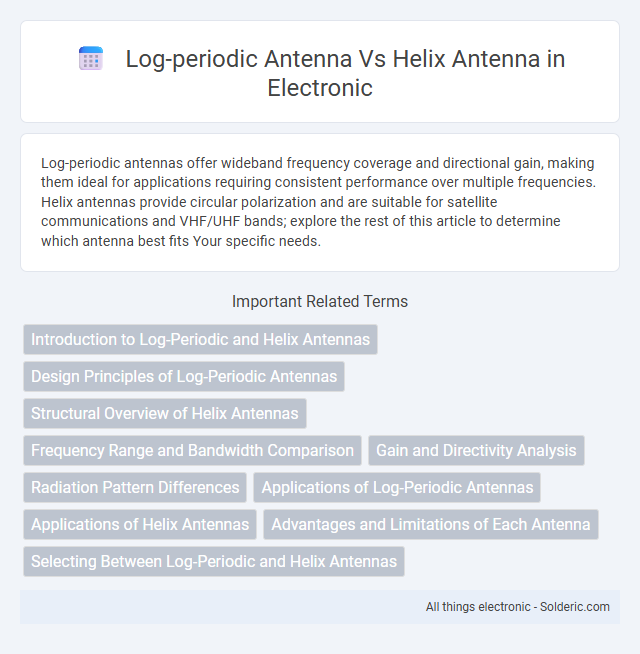Log-periodic antennas offer wideband frequency coverage and directional gain, making them ideal for applications requiring consistent performance over multiple frequencies. Helix antennas provide circular polarization and are suitable for satellite communications and VHF/UHF bands; explore the rest of this article to determine which antenna best fits Your specific needs.
Comparison Table
| Feature | Log-Periodic Antenna | Helix Antenna |
|---|---|---|
| Frequency Range | Wideband, typically 2:1 or higher ratio | Narrow to moderate bandwidth, often single band |
| Polarization | Linear polarization | Circular polarization |
| Radiation Pattern | Directional, moderately high gain | Directional with high gain and axial mode |
| Gain | 6 to 12 dBi | 10 to 15 dBi |
| Size and Shape | Flat, planar structure | 3D helix geometry |
| Application | TV reception, broadband communications, scanning | Satellite communication, GPS, telemetry |
| Impedance | Typically 50 ohms | 50 or 75 ohms depending on design |
| Construction Complexity | Moderate | Higher due to 3D winding |
Introduction to Log-Periodic and Helix Antennas
Log-periodic antennas are broadband directional antennas characterized by multiple elements with gradually varying lengths and spacings, enabling consistent performance over a wide frequency range. Helix antennas consist of a conducting wire wound in a helical shape, known for their circular polarization and high gain, primarily used in satellite and VHF communications. Both antenna types serve distinct applications, with log-periodic antennas excelling in frequency versatility and helix antennas in circularly polarized, directional signal transmission.
Design Principles of Log-Periodic Antennas
Log-periodic antennas are designed based on the principle of self-similarity, using a series of dipole elements with gradually varying lengths and spacing to achieve wideband frequency coverage. Each element resonates at a specific frequency, allowing the antenna to maintain consistent impedance and radiation patterns across a broad spectrum, typically from 200 MHz to several GHz. This geometric progression design enables predictable performance and efficient signal capture in applications such as television reception, HF communications, and broadband scanning.
Structural Overview of Helix Antennas
Helix antennas consist of conductive wire wound in a helical shape around a central axis, usually supported by a dielectric or metal tube, enabling circular polarization and broad bandwidth. The structural design includes parameters like helix diameter, pitch angle, and number of turns, which directly influence radiation pattern, gain, and axial mode operation. You can optimize helix antennas for satellite communications and wideband applications by adjusting these geometric factors to achieve desired directional properties and impedance matching.
Frequency Range and Bandwidth Comparison
Log-periodic antennas cover a wide frequency range with consistent gain, making them ideal for applications requiring broad bandwidth, typically spanning several octaves. Helix antennas offer narrower bandwidth but excel in circular polarization and gain within their operating range, usually covering about one octave or less. Your choice depends on whether a broader frequency range or specific polarization and gain characteristics best suit your communication needs.
Gain and Directivity Analysis
Log-periodic antennas offer moderate gain typically ranging from 6 to 10 dBi with wide bandwidth and relatively lower directivity, making them suitable for applications requiring frequency agility. Helix antennas provide higher gain, often between 12 to 16 dBi, with strong directivity concentrated in the axial mode, ideal for long-distance communication with focused beams. Your choice depends on whether you prioritize broader frequency coverage or enhanced gain and directional performance.
Radiation Pattern Differences
Log-periodic antennas exhibit a directional radiation pattern with multiple lobes and moderate gain, making them ideal for wideband applications and consistent performance over a broad frequency range. Helix antennas typically produce a highly directional, circularly polarized radiation pattern with a single main lobe and higher gain, suited for satellite communications and applications requiring robust signal penetration. The distinct radiation pattern of the helix antenna provides better axial mode performance, while the log-periodic antenna offers frequency agility with stable directional characteristics.
Applications of Log-Periodic Antennas
Log-periodic antennas are widely used in applications requiring wideband frequency coverage and directional signal reception, such as television broadcasting, spectrum monitoring, and electromagnetic interference testing. Their ability to operate efficiently across a broad range of frequencies makes them ideal for measurement systems and communication devices needing consistent gain and impedance characteristics. Industries like telecommunications, aerospace, and radar systems frequently utilize log-periodic antennas for reliable wideband performance.
Applications of Helix Antennas
Helix antennas are widely used in satellite communication, space telemetry, and GPS systems due to their circular polarization and wide bandwidth capabilities. Their ability to maintain stable signal reception in varying orientations makes them ideal for mobile and aerospace applications. You can rely on helix antennas for robust performance in tracking and wireless communication in complex environments.
Advantages and Limitations of Each Antenna
Log-periodic antennas offer wide bandwidth and consistent gain across a broad frequency range, making them ideal for applications requiring frequency agility; however, their complex structure can be bulky and challenging to fabricate. Helix antennas provide circular polarization and high gain with a relatively simple design, which suits satellite and space communication, yet they are generally limited to narrower bandwidths and larger physical sizes compared to log-periodic antennas. Both antennas balance trade-offs between bandwidth, polarization, size, and complexity, guiding their suitability for specific communication systems.
Selecting Between Log-Periodic and Helix Antennas
Log-periodic antennas offer wide bandwidth and high gain across multiple frequency bands, making them ideal for applications requiring versatile frequency coverage, such as TV reception and spectrum monitoring. Helix antennas provide circular polarization and consistent gain, suitable for satellite communications and applications needing robust signal integrity in multipath environments. Selecting between log-periodic and helix antennas depends on the need for broad frequency agility versus circular polarization and directional stability.
log-periodic antenna vs helix antenna Infographic

 solderic.com
solderic.com